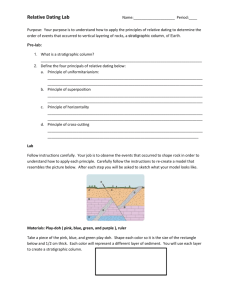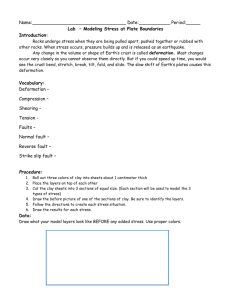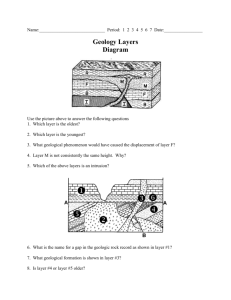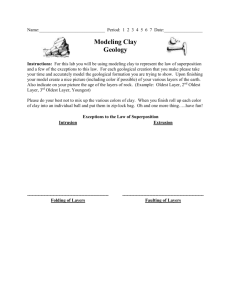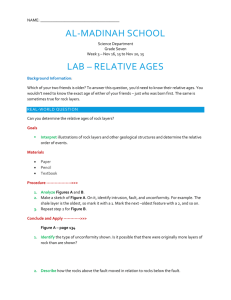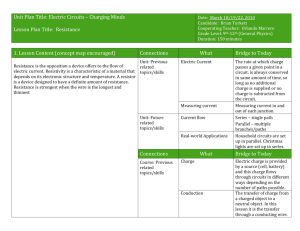Play-doh Tectonics - H
advertisement
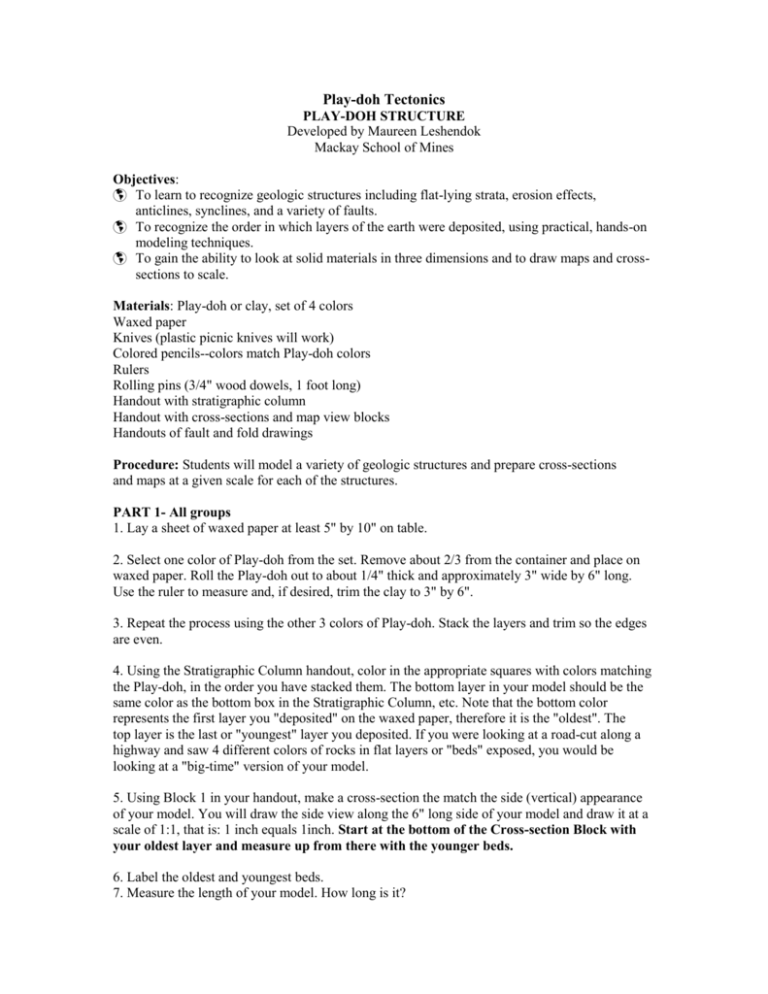
Play-doh Tectonics PLAY-DOH STRUCTURE Developed by Maureen Leshendok Mackay School of Mines Objectives: To learn to recognize geologic structures including flat-lying strata, erosion effects, anticlines, synclines, and a variety of faults. To recognize the order in which layers of the earth were deposited, using practical, hands-on modeling techniques. To gain the ability to look at solid materials in three dimensions and to draw maps and crosssections to scale. Materials: Play-doh or clay, set of 4 colors Waxed paper Knives (plastic picnic knives will work) Colored pencils--colors match Play-doh colors Rulers Rolling pins (3/4" wood dowels, 1 foot long) Handout with stratigraphic column Handout with cross-sections and map view blocks Handouts of fault and fold drawings Procedure: Students will model a variety of geologic structures and prepare cross-sections and maps at a given scale for each of the structures. PART 1- All groups 1. Lay a sheet of waxed paper at least 5" by 10" on table. 2. Select one color of Play-doh from the set. Remove about 2/3 from the container and place on waxed paper. Roll the Play-doh out to about 1/4" thick and approximately 3" wide by 6" long. Use the ruler to measure and, if desired, trim the clay to 3" by 6". 3. Repeat the process using the other 3 colors of Play-doh. Stack the layers and trim so the edges are even. 4. Using the Stratigraphic Column handout, color in the appropriate squares with colors matching the Play-doh, in the order you have stacked them. The bottom layer in your model should be the same color as the bottom box in the Stratigraphic Column, etc. Note that the bottom color represents the first layer you "deposited" on the waxed paper, therefore it is the "oldest". The top layer is the last or "youngest" layer you deposited. If you were looking at a road-cut along a highway and saw 4 different colors of rocks in flat layers or "beds" exposed, you would be looking at a "big-time" version of your model. 5. Using Block 1 in your handout, make a cross-section the match the side (vertical) appearance of your model. You will draw the side view along the 6" long side of your model and draw it at a scale of 1:1, that is: 1 inch equals 1inch. Start at the bottom of the Cross-section Block with your oldest layer and measure up from there with the younger beds. 6. Label the oldest and youngest beds. 7. Measure the length of your model. How long is it? PART 2- All groups Simulate the erosion of a canyon by cutting through successive layers of the Play-doh. Make the canyon in the middle, across the surface of the model on the 3-inch dimension: 1. Slice the top layer vertically at 2" from either end, being careful to cut into the top layer only. 2. Slice the next layer on a gentle slope inwards (toward the center), beginning at the point where the cut in the top layer touches the second layer. 3. Make vertical cuts in layer 3 from the points where the slope of layer 2 touched it. 4. Slice layer 4 (the bottom layer) inwardly (toward the center of the model) at a very shallow angle. BE SURE TO SAVE THE REMOVED CLAY PIECES. DON'T SQUASH OR DEFORM THEM!!!!! 5. Using Block 2, draw a map of the topography that you see. Use your ruler to measure the widths of each exposed layer on each side of the canyon you created. 6. Using Block 3, draw a cross-section showing the canyon, using the same methods employed in Part 1. 7. Label the youngest and oldest layers on both the map and cross-section. 8. Would the layers that make up the cliffs (steep sided sections) be softer or harder than the layers that make up the gradually sloped sides of the canyon. Replace the clay you removed and heal the cuts before proceeding with the next assigned part of the lab PART 3 Group 1 1. "Heal" the canyon made in Part 2 by replacing the clay removed from each layer, keeping the color layers as they were. 2. Place your hands on the ends of the model and press gently together horizontally. Let the waxed paper slide with the model. You should end up with an anticlinal and a synclinal fold (See Fold and Fault handouts). Stabilize the folded layers by adding clay beneath the bottom layer, as needed. You may want to give your model a little additional hand-shaping to obtain the desired fold shapes. NOTE: You have modeled the effects of compressive stress upon horizontal rock layers. 3. Make a cross-section of your folded model using Block 4. It should be at a scale of 1:1 as in Part 1, Step 5. Be sure to use the ruler to measure accurate distances and thicknesses of layers. 4. Label the oldest layer ("bed") and the youngest layer ("bed") on your cross-section. 5. Measure the length of the model. Is it shorter or longer than the unfolded model? PART 4- Group 2 1. Use the knife to make a slanting cut from top to bottom through the Playdoh model, parallel to the model's short axis. 2. A block on one side of the cut will be lower than the other side. Place some of the left-over Play-doh beneath the lower block so that the block will be raised to a slightly higher elevation than the other block. Push the two halves of the model together so they just barely touch. 3. Draw the resulting model in cross-section using Block 5 and the scale of 1:1.The structure you have drawn is called a "Normal Fault". 4. Measure the length of the model. Is it shorter or longer than it was before you "faulted" the model? PART 5- Group 3 1. Use the knife to make a slanting cut from top to bottom through the Playdoh model, parallel to the model's short axis. 2. A block on one side of the cut will be higher than the other side. Place some of the left-over Play-doh beneath the lower block so that the block will be raised to a slightly higher elevation than the other block. Push the two halves of the model together so they just barely touch. 3. Draw the resulting model in cross-section using Block 5 and the scale of 1:1.The structure you have drawn is called a "Reverse Fault". 4. Measure the length of the model. Is it shorter or longer than it was before you "faulted" the model? PART 6 -Group 4 1. For this part of the activity, you will be looking down on the model, rather than looking at it in cross-section. Scratch a lengthwise line on the top layer of the model. This could represent a road, stream, fence-line, or some other linear feature. 2. Move the two halves of the model horizontally in opposite directions so that the scratch (road, etc.) is separated by about a quarter to a half inch. You have created a "Strike-slip Fault". 3. Turn the model so the "fault line" is parallel to the edge of the table where you are sitting. Look at the portion of the model on the far side of the "fault". Is it to the right or to the left of the portion of the model nearest you? If the far side is moved to the left, then your "Strike-slip Fault" is left-lateral. If the far side is moved to the right, then the fault is right-lateral. 4. Draw the right-lateral and left-lateral faults you have modeled using Blocks 7 and 8 of the handout. NOTE: These drawings are known as "Map" or "Plan" view drawings. If drawn at the 1:1 scale, portions of the fault blocks will go outside the lines on the handout. All groups- look at the geologic formations made by the other groups and answer all questions and make drawings for each block. STRATIGRAPHIC COLUMN YOUNGEST OLDEST BLOCK 1 BLOCK 2 BLOCK 2 BLOCK 3 BLOCK 2 BLOCK 4 BLOCK 5 BLOCK 2 BLOCK 6 BLOCK 7 BLOCK 2 BLOCK 8
